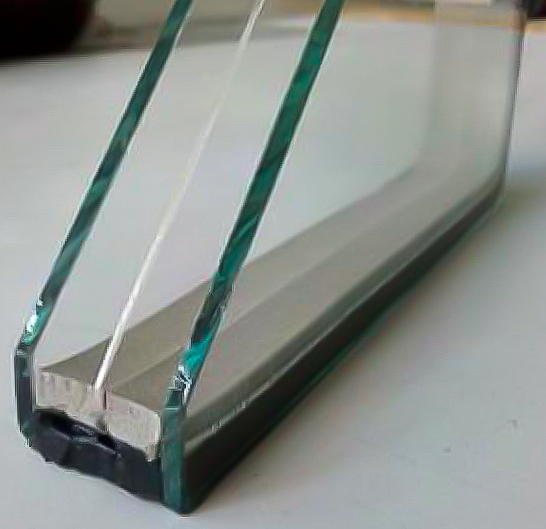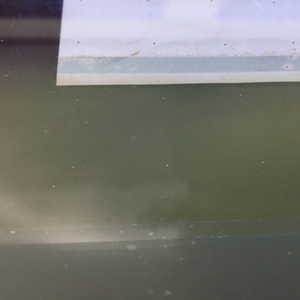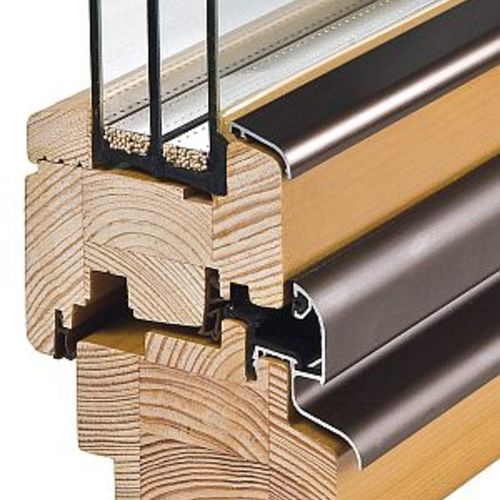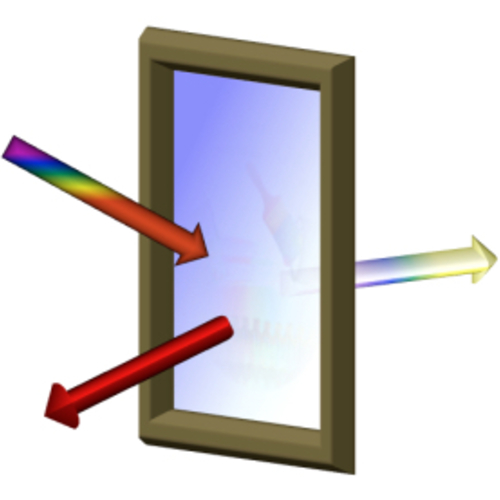
Image Credit: Lawrence Berkeley National Laboratory
Researchers at the Lawrence Berkeley National Laboratory (LBNL) have developed a new type of triple glazing for windows that is about the same thickness and weight as a standard low-e double-glazed window but comes with twice the insulating value.
In a news release, the U.S. Department of Energy laboratory said the breakthrough is made possible by the availability of extremely thin glass for the flat screen television industry. The glass, only 0.7 mm (less than 1/32 inch) thick, is used for the center pane in the triple-glazed assembly. Krypton gas replaces the argon typically used in double-glazed units.
High-performance triple-glazed windows, such as those used in Passive House buildings, are readily available today. But they are thicker and heavier than standard double-glazed units and many builders order them from Europe, extending construction schedules or forcing builders to plan carefully. Because the glass in these new “thin triple super windows” is so thin, the assembly delivers high R-value without a redesigned window sash or frame.
The windows have a center-of-glass R-value of between R-8 and R-10, about twice that of the best low-e double-glazed windows currently on the market, the lab said.
The lab has built prototypes and is working with two manufacturers — the Andersen Corporation and Alpen High Performance Products — to build and test prototypes that would be suitable for large-scale production.
The press release noted that the laboratory’s work on high-performance windows dates to the oil crisis of the 1970s when it pioneered the development of low-e coatings. Charlie Curcija, one of the LBNL researchers, said the super-window might have come along sooner had large sheets of very thin glass been available.
“The thin glass is 0.7 mm thick,” he said. “Twenty years ago we couldn’t find any companies that could make thin glass sheets in volume. Now the flat screen TV industry has pushed the glass industry to create precisely the glass we need for windows, and at a price the window market can afford.”
The benefits of a drop-in replacement
The availability of a high-performance drop-in replacement for double-glazed sash could lower risks for manufacturers who want to begin making triple-glazed units while expanding the potential market beyond its current 2% share, said LBNL researcher Stephen Selkowitz.
“As a ‘drop in’ insert with virtually the same weight and width as the existing [insulated glass unit], the barriers and risks of market entry to the window manufacturer are much lower and the major added cost is the marginal cost of the extra sheet of glass, the [krypton] gas fill, and a second low-e coating plus some additional assembly,” Selkowitz said in an email.
He said added costs at the manufacturer’s level would be about $2 a square foot, although the consumer would pay more than that. Where the new windows replaced existing double-glazed units, payback would come in 5 to 7 years.
“We think ultimately the market will go beyond comparing the price of the two products and energy only,” he added. “There will be other important benefits and value: improved thermal comfort, larger windows with better views with no penalty in energy, the potential for downsizing HVAC, and eliminating duct runs to the perimeter, etc.”
Another advantage, he said, would be eliminating shipping costs and time delays that come with ordering high-performance triple-glazed windows from Europe.
The LBNL super-window is similar in design to windows made by Alpen, except that Alpen’s version uses Heat Mirror, a polyester-based film manufactured by Eastman Chemical, instead of glass as the center pane. Selkowitz noted this in his email but added, “we think the thin glass will simplify their assembly process and lower their costs.”
Alpen CEO Brad Begin said by telephone the thin triple technology could become part of the company’s product lineup, but as a complement to Heat Mirror rather than a replacement.
“We’ve been making Heat Mirror successfully for over 30 years and remain very committed to the technology and find it to be very effective,” he said. “Having said that, as a company known for commercializing innovative technologies, we’re intrigued by the opportunities to at least experiment with thin glass.”
Begin said that it’s probably too early to say whether the thin-glass triple units would be less expensive to manufacture than Alpen’s Heat Mirror windows. “The jury is still very much out on that,” he said, adding that the technology could be very attractive to window manufacturers who are not accustomed to working with thick glazing, what Begin calls “wide pockets.”
Production decisions lie ahead
One key question is when windows with the new glazing might be commercially available. It’s really too soon to say with any certainty, according to Selkowitz, although a small company conceivably could be offering windows with the glazing in low volume in a year.
“As you might imagine, the decision-making process and timeline is different for different companies,” he said, “so our goal is to provide them with the technical information needed [as a] step in the process to proceed along that decision-making timeline as rapidly as possible.”
At this point, LBNL is working on market acceptance, durability, and fabrication issues. Part of that involves hand making some prototypes for use in field tests this coming winter. The next step for manufacturers would be to explore scaled-up production on semi-automated or automated production lines.
But so far, so good.
“We produced our first window last week,” Begin said. “The question is how far out is realistic [for manufacturing]? We’re still doing our testing, still doing our collaborative work with LBNL to make sure it’s got the durability and all the things we need. But it’s manufacturable today … For the larger current insulated glass manufacturers, my guess is if their customers wanted them to make it they could figure how to make it fairly quickly.
“It’s been remarkably easy so far, but I don’t think we’ve come close to testing the size of the units that may be necessary to realistically commercialize the product, assuming that it will get more and more challenging as it gets bigger. But it’s been surprisingly easy so far.”
Andersen’s representative on the research team is Katherine Graham, the company’s glass competency team leader. She could not be reached for comment.
Weekly Newsletter
Get building science and energy efficiency advice, plus special offers, in your inbox.















25 Comments
Can more detail be provided?
Getting Andersen to supply an affordable triple-pane in the advertised R-8 to R-10 range likely would lead to much higher adoption of highly energy efficient windows. A great accomplishment IMHO!
How do you get to R-8 to R-10 center of glass with a narrow triple pane? Krypton helps some, and heat mirror surface treatments aren't mentioned but must be part of the assembly. Could you detail the contribution of each item to get to R-8 to R-10?? Doing this affordably is another challenge. A narrower window uses less Krypton but still...
Robert,
Have a look at https://www.greenbuildingadvisor.com/article/curious-case-imploding-windows for more info and the risk when you use HEAT MIRROR from Eastman with Krypton gas manufactured by Eco Insulating Glass Inc.
Response to Robert Opaluch
Robert,
Good question; perhaps Scott Gibson will provide more information.
Below is a slide from a PowerPoint presentation by LBNL researcher Steve Selkowitz. Not much new information here -- other than a few details of Selkowitz's vision of this "super window."
I don't see anything magic -- just two low-e coatings and the use of krypon (which is both more expensive than argon, and more effective than argon at improving an IGU's thermal performance when the gap between window panes is small).
.
Why not make all the panes
Why not make all the panes out of the thin glass?
Response to Jay S
Jay,
I assume the answer is that the thin glass is too fragile for that purpose.
Too fragile, AND too expensive @ Jay, Martin
To have the necessary strength even for use indoors on a big-screen, 0.7mm TV glass is already pretty expensive stuff compared to the glass used in the other panes. (In super-high volumes a window manufacturer can probably get their cost down to $15-20 per square meter for just the un-coated glass.) The raw glass cost of just the thin glass pane is probably a multiple of the cost other two panes combined.
VIG Still Waiting
Still waiting on VIG windows which were supposed to be commercialized a few years ago. Plygem was showing them off in Jan 2018 at a tradeshow. I think the issue is having a durable metal flexible seal for the vacuum. VIG seems like a better super window technology if they can get the seal right.
https://twitter.com/guardianglass/status/951475294678016001
Additional details
After Robert Opaluch posted his question, I emailed Steve Selkowitz at the Berkeley Lab and asked him if he would respond with more details about the window. Here is his response:
It's great to see the interest — both enthusiasm and skepticism — in this topic. I've tried to address several respondents collectively below.
There are multiple options to achieve highly insulating windows. Although the industry has made great progress in moving from conventional double-glazing (~R2 windows) to low-E double-glazing (R3 windows), which now represent about 85% of all windows sold, triple-glazing has remained for decades at only 1-2% of all window sales. A well-designed triple-glazed window (with a glass or Heat Mirror coated plastic layer) can achieve an R4-8 value. Another side note: the total window R value (above) is the area weighted combination of the center of glass value, an edge of glass value and a sash/frame value. For these high-performance windows, the glass is typically the best performing and the glass edge/sash/frame lowers the total value. So, for example, a typical low-E, argon-filled insulating glazing unit (IGU) is about R4 but the total window is R3 because the typical frame is worse.
Vacuum insulating glazings (VIG) have been under development for decades. One product has been commercially available for 15 years, several new products from additional companies are on the way, but there are no new options today. Some redesign is needed so the sash can accommodate a VIG, and the current costs are not cheap. Hopefully all this will improve over time.
American windows tend to have thinner profiles than European windows and thus the most common window IGU is about 0.7 inches wide — two pieces of 0.11-inch glass and a 0.5-inch air space. If every builder and homeowner doing retrofits demanded triples today, most window companies would make the investments to retool their production lines to accommodate a 1.25-inch wide triple IGU, which also weighs 50% more than a double (three layers of glass vs. two). But there is no substantial market demand so triples are often special order products, which adds to the market cost. Why not make the air space thinner? Because thermal properties (for air and argon) are best at 0.5 inches. If you make a conventional triple with 0.125-inch air gaps the performance gets much worse.
The LBNL project described in this press release is promoting a high-performance package that allows a manufacturer currently offering a standard R3 window to offer an R5-7 window by simply replacing the existing 0.7-inch IGU with a new 0.7-inch IGU with a much higher R value — now R8-9 vs. the traditional R4-5 for the double IGU. The new "thin triple" IGU is about the same weight. The new IGU has the extra piece of thin glass (so little change in weight), which creates two thin air spaces (a second low-E coating is added to the new air space); but now the gaps are filled with krypton rather than argon or air to improve the thermal properties to the same level as if it were a 0.5-inch gap with argon. The specific properties depend on spacing, gas fill mix and emissivity of the low-E coating. Over the last 10 years, LBNL has built and tested a large number of prototypes confirming that the U (or R) value of these IGUs is as expected. These can all be calculated using the WINDOW software tool (free on the LBNL website).
What about thin glass and krypton? LBNL has a patent on this design from 1991 (now expired), but at that time thin glass wasn't available and krypton was very expensive. Five years ago we built prototypes using the Gorilla glass developed for cell phones. It worked well but the glass was ~$5/sf and the equivalent cost of Kr was $2/sf. Today, these figures have changed dramatically in our favor (good things sometimes do come to those who wait). The flat screen TV industry now consumes 2 billion square feet of thin glass globally and the price of the 0.7mm glass we have been using has dropped well below $1/sf. The price of Kr has fallen to ~$.50/sf. The light bulb market that used Kr is declining rapidly due to LEDs, and the satellite market for Xenon (used in thrusters to position communications satellites) is rapidly increasing (Kr is a byproduct of extracting Xenon). So we estimate the marginal OEM cost to add thin glass, Kr and a second low-E coating is below $2/sf. (There are some assembly costs and the supply chain markups before you reach a consumer cost).
One person asked about handling and breakage. Our view is that if 2 billion square feet per year of thin glass is cut, transported, cleaned and assembled into TVs without difficulty then those challenges, which are real, are readily solvable by the window industry as well. The glass can be chemically strengthened but that adds cost and is unnecessary in our view because it is protected inside the IGU. There are new challenges to incorporate the glass layer into an IGU in a way that permits automated assembly. Our design places it inside the spacer. We do not add an extra spacer, which reduces costs and the probability of seal failure. But there are still design challenges here which are the subject of our joint efforts with industry partners.
Thin glass will soon be available with a low-E coating. This allows a quad-glazed IGU package only 1.2 inches wide to achieve an R15 value for the IGU. The final total window U value will depend on the details of the sash and frame.
In parallel with working on the IGU/window technology, we are working with utilities on potential incentive and rebate programs to jump start a market, with code officials contemplating tighter future requirements (in Canada and several states in the U.S.) or tradeoffs for other prescriptive features (California in new Title 24 2019 standards), and with the industry generally to quantify other benefits. Those include improved thermal comfort, the ability to reduce or eliminate perimeter ducts and downsizing HVAC equipment.
The busy chart below shows the IGU U value (and R) for four IGU designs: double, double with surface 4 low-e, triple and quad configurations as a function on horizontal axis of overall IGU width; each cavity has a low-E coating. The overall width includes two layers of single-strength glass and 0.7mm thin glass. For each colored band the upper solid line is 95% argon fill; the lower dotted line is 95% Kr fill.
We believe this is a promising approach to dramatically improve thermal properties, with modest risk and reasonable costs. There are certainly remaining technical and business/market challenges to be solved, which is the purpose of the collaborative research program underway.
Comments and suggestions are welcome. Additional information can be found at https://windows.lbl.gov/triple-glazing-thin-non-structural-center-glass, including a list of downloadable reference documents. A comprehensive overview of all this material will be available in a conference paper in August.
Scott Gibson/ Steve Selkowitz. Looking at the graph, does that assume a particular delta T?
Thomas,
The graph show center-of-glass U-factor on the Y axis and the width of the insulated glazing unit (in inches) on the X axis. Both of these metrics are independent of delta T.
In other words, the U-factor of the center of the glass is constant, regardless of the delta T. For more information on U-factor, see "All About U-Factor."
I assume that as the "width" increases the air space increases. My understanding is that the optimal air space varies depending on the delta T.
Scott Gibson,
Perhaps I was not very clear on my last post. Most simulations assume a particular delta T. Do you have the delta T used in the simulation that produced the graph? Wondering what that graph would look like with a delta T of 25 degrees F. I live in Santa Cruz CA so I would find that interesting. The delta T used by NFRC tends to skew the optimal air space to one smaller one than optimal for our climate here on the central coast. I learned this from Bronwyn Barry a few years back.
Thomas,
The LBNL paper is addressing the U.S. window market, so it's reasonable to assume that the researchers are using the U.S. method of measuring U-factor, not the European method of measuring U-factor.
The U.S. definition of window U-factor requires windows to be tested at an outdoor temperature of 0 degrees F.
For more information on the different ways that Americans and Europeans measure window U-factor, see my article, "All About U-factor."
Martin, what is the indoor temperature in the U.S definition? Back to my delta T question. The convection loops in the air space are stronger at a higher delta T.
70F is the indoor temp for US window U-factors, so a 70F delta-T.
But it's not as simple as delta-T. Low-E window performance is also a function of the fourth power of the absolute temperature (above absolute zero), and thus strongly non-linear with outdoor temperature even with the same delta-T.
Crap! Thought I sort of understood this stuff.
So if Scott Gibson had any interest in running the number for my climate, go with 45 F ext and 70F interior.
It's not very simple to just "...run the number..." for your specified temperature conditions, but if you think want to give it a shot, read this first:
https://uwspace.uwaterloo.ca/bitstream/handle/10012/11549/16-SL-08-020.pdf?sequence=1
Thanks. Yikes!
This is exciting stuff, but as stated in the article, it doesn’t look like it’s going to hit the mass market anytime soon unfortunately. I came to this post while researching triple glazed windows. I am working on an affordable multiunit housing project that will require 64 windows. My current choice is the unsexy but dependable American craftsman 70 series. It’s manufactured by Andersen and found at Home Depot. I have installed 30 of them over the past 10 years in a building that I manage and they hold up well. Price is in the low $200 for a 33" by 54" (about 10 sqft) double hung. U-value is 0.33 (R-3 more or less)
I’d be willing to pay a 50% premium of about $100 extra per window to go from R-3 to R-4. That’s the most I could justify in our Boston climate. Of course, higher than R-4 would be better, but likely out of my budget of $350 max per window.
I’d be willing to stretch to $500 for something with R-8 to R-10 like what’s mentioned in the article, but only once reliability has been proven. It would be a disaster if I had to replace $40k of windows (with labor) within 5 to 10 years because the seal or something else is failing, and I am not willing to take that chance.
I spent some time researching this topic online including this site, but I can’t find much information about triple glazed or other higher performance windows when money IS the object.
Has anyone found and installed R-4 or above windows for under $400 a piece? If so, I would love to hear about it!
Vivian,
Q. "Has anyone found and installed R-4 or above windows for under $400 apiece? If so, I would love to hear about it!"
A. I suggest that you post this question on the Q&A page -- that way you are more likely to get an answer from the GBA community. Here is the link: Q&A page.
“[Deleted]”
I've got requests out for quotes from both Andersen and Alpen to outfit a 3200ft Prairie style home we're about to build in Bend, Oregon with the new "super windows."
We'll probably only do single-hung and fixed styles.
Will gladly update you guys with my findings.
Have you received any quotes?
I've received one direct from Alpen.
(example pricing for fiberglass casement and fixed style below)
My local lumber yard rep has been trying to get something from Andersen but so far whoever he spoke to over there had no clue about any triple pane with tiny glass or gorilla glass in the middle...
Just sharing an update to the story. We're coming up on mid-2023 now and Alpen High Performance Products is just about to pass one million square feet of ThinGlass.
Since 2018, there's been numerous studies on ThinGlass; my favorite is the DOE (Department of Energy) destruction testing where it took 240mph to shatter the ThinGlass. Remarkably, the 1/8" glass on the exterior broke way before the ThinGlass. It's kind of bizarre, but since ThinGlass is 27x more flexible, it can withstand more force; cool when you think about it!
Log in or create an account to post a comment.
Sign up Log in